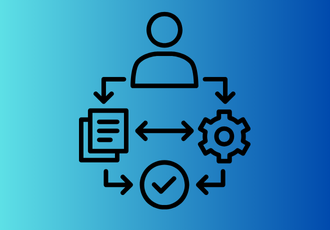The traditional patient intake process often relies on paper forms, manual data entry, and front-desk bottlenecks. Patients fill out questionnaires upon arrival, staff transcribe handwriting into electronic health records (EHR), and insurance is verified via phone calls, leading to long wait times, transcription errors, and frustrated patients.
Digital patient intake forms transform this experience. As part of a broader digital transformation in healthcare, these solutions accelerate registration, improve accuracy, and free staff to focus on care.
This article will cover how digital intake forms work, their advantages, and how platforms like FlowForma are modernizing the patient intake process for the healthcare industry.
What Are Digital Patient Intake Forms?
 An example of a digital intake form used in a healthcare setting
An example of a digital intake form used in a healthcare setting
Digital patient intake forms are secure, web-based questionnaires that replace paper documents to capture patient demographics, medical history, and insurance details.
They integrate directly with your EHR or practice management systems, reducing manual steps and improving data quality.
What Are the Key Steps in the Traditional Patient Intake Process?
Before digital intake forms became an option, patient intake typically involved several manual steps. Here's a breakdown of how the traditional patient intake process works:
-
Patient Registration: Upon arrival at the clinic, hospital, or doctor’s office, the patient fills out paper forms with personal information, medical history, and insurance details.
-
Data Entry: Staff members will manually input this information into their EHR systems. This process is labor-intensive and susceptible to errors such as typos, omissions, or misinterpretation of handwriting, which can impact patient safety and data accuracy.
-
Insurance Verification: Next, staff will manually verify insurance details, often by calling insurers or using outdated verification systems, which can lead to delays in treatment, billing errors, or issues with coverage confirmation.
-
Long Wait Times: Once the registration and verification stage is completed, patients face long wait times before eventually seeing a healthcare provider, due to process inefficiencies and front-desk bottlenecks.
While these steps in the patient intake process are essential for delivering care, the traditional method is far from ideal. Compared to digital intake forms, it relies heavily on physical paperwork, manual data entry, and outdated systems.
Digital intake forms streamline and modernize the entire process, making it faster, more accurate, and more convenient for both patients and staff.
Challenges of a Manual Patient Intake Process
According to a recent guide on healthcare process digitalization by FlowForma, the top three impacts of paper processes on hospitals are missing data (84%), poor visibility (80%), and inefficiencies (75%).
 Hospital-based paper processes cause barriers to digitalization, underscoring the need for digital intake forms.
Hospital-based paper processes cause barriers to digitalization, underscoring the need for digital intake forms.
Manual patient intake methods have been used for years, but they come with several challenges that negatively impact both healthcare providers and patients.
Here are a few of these:
- Inefficiency: Paper forms require a significant amount of time for patients to fill out and for staff to input into the system. This leads to long wait times and delays in patient care.
- Data Entry Errors: Manual transcription increases the risk of inaccurate or incomplete information, such as incorrect contact details or missing medical history. These errors can impact patient safety and treatment.
- Lack of Integration: Manual processes are often siloed, meaning that information entered into one system doesn’t automatically integrate with others. This makes it harder to maintain up-to-date patient records and results in inefficiencies when cross-referencing data.
- Compliance Issues: Ensuring that paper forms comply with regulations such as the Health Insurance Portability and Accountability Act (HIPAA) can be challenging. Mistakes in paperwork or data storage could increase the risk of non-compliance and compromise patient privacy and data security.
These challenges not only affect the overall patient experience but also increase the administrative burden on healthcare providers.
Key advantages of the digital patient intake process

Modern digital intake forms are more effective for faster and more accurate patient onboarding compared to traditional paper workflows.
To truly benefit, healthcare organizations must replace paper forms with a digital patient intake solution. Switching to a digital process offers significant improvements over traditional methods. Below are some of the key benefits of following a digital patient intake process:
1. Faster, more efficient processing
Allowing patients to enter their details online—either via a pre-visit link or on a tablet in the waiting room significantly reduces wait times and eliminates manual hand-offs.
For example, platforms like FlowForma provide no-code form templates and AI-assisted workflows that let you deploy new intake forms in minutes, helping healthcare teams process information faster and focus more on delivering quality care.
2. Fewer errors, more accuracy
Digital solutions help reduce data entry errors. Built-in validation checks ensure that the patient’s information is correct and complete before submission. Additionally, electronic submission eliminates issues such as illegible handwriting or misplaced forms, thereby reducing the risk of lost or incorrect data.
You can read more about the benefits and challenges of automation in healthcare.
3. Enhanced security and compliance
One of the most critical aspects of managing patient information is ensuring its security and privacy. With digital patient intake forms, patient data is encrypted and stored securely, enabling healthcare providers to stay compliant with HIPAA and other privacy regulations.
Tools like FlowForma reinforce this with built-in security protocols and audit trails that safeguard sensitive data at every step of the intake process—ensuring both compliance and peace of mind for patients and providers alike.
4. Cost savings
While adopting digital solutions may have an initial investment, the long-term savings are substantial. By eliminating paper forms, reducing errors, and improving staff efficiency, healthcare organizations can lower overall operational costs. This leads to improved profitability and better resource allocation in the long run
5. Personalized Onboarding for Every Visit
One of the biggest advantages of digital patient intake is personalization. By using online patient intake forms with conditional logic, you can tailor the steps of the patient intake process so that only relevant questions appear based on visit type—whether it’s a routine check-up, specialist consultation, or follow-up.
This approach makes patients check in faster, reduces form fatigue, and boosts completion rates. Plus, the same data can seamlessly feed into post-visit workflows like healthcare claims automation to further streamline your operations.
 Healthcare claims processing in six steps
Healthcare claims processing in six steps
Case Study: How a European Hospital Replaced Paper-Based Processes with FlowForma
A European hospital, home to nearly 1,000 beds and thousands of staff across 50 specialties, struggled under an overwhelming volume of paper forms.
Critical workflows such as waiting list referrals, theatre notes, and HR approvals were manual, siloed, and prone to errors. Clinicians spent valuable time hunting for documents instead of treating patients.
To tackle this, the hospital’s IT team deployed FlowForma on Microsoft SharePoint, enabling a no-code approach to digitize key processes.
Within weeks, a small group of trained staff rolled out digital workflows that spanned 14 IT systems and replaced dozens of paper forms.
 Feedback from the Head of IT on the positive impact of FlowForma
Feedback from the Head of IT on the positive impact of FlowForma
Processes digitized
- Digitized waiting list forms: Completed in 30 seconds from form launch to admission routing
- Theatre notes workflow: Pre-populated e-forms filled in under 2 minutes and shared instantly with nursing teams
- Clinician-centric design: No-code interface praised as “crisp and attractive” for its simple interaction
- Eliminated paper: PDF summaries stored directly against patient records for instant retrieval
Outcome: patient wait times cut to 10 seconds, enabling faster, error-free digital patient check in.
Read the full case study to see how FlowForma helped transform paper-based operations into efficient, digital workflows
What are the key components of a digital intake form solution?
For a digital intake solution to be effective, it needs to incorporate several key features. Here are a few highly recommended features:
1. Form automation
Automated form generation simplifies the creation and submission of intake forms, reducing administrative burden, especially for non-technical staff. Watch this video to see how easily forms can be created, customized, and deployed without any coding using FlowForma.
For instance, clinics and hospitals that utilize FlowForma’s AI-powered form automation eliminate manual setup and ensure that every patient sees only the fields they need, thereby reducing administrative work and speeding up submissions.
Watch how Blackpool Teaching Hospitals NHS Trust revolutionized its workflows by moving from paper to digital forms using FlowForma.
2. Secure data storage
The digital intake form solutions you choose should be able to store patient data securely in cloud-based systems that comply with industry regulations. This ensures that you maintain patient confidentiality and your healthcare professionals have access to a single source of truth for data.
FlowForma encrypts and backs up every submission, giving your team one single source of truth and keeping you fully compliant with healthcare regulations like the General Data Protection Regulation (GDPR) and HIPAA.
3. System integration
A great digital intake solution integrates directly into your existing EHR, practice management, and insurance-verification tools. If you select a tool that is not compatible with your current systems, you will have to spend more money on integration.
 FlowForma’s integration capabilities enable seamless data exchange between existing EHR, billing, and insurance systems.
FlowForma’s integration capabilities enable seamless data exchange between existing EHR, billing, and insurance systems.
4. Customizable workflows
Digital intake forms should be flexible enough to match your processes, whether that involves routing to different departments, triggering alerts, or collecting specialty-specific data.
With FlowForma’s drag-and-drop workflow designer, you can configure these processes in minutes, not months, and achieve seamless healthcare workflow automation. Workflows can also be assigned to team members and monitored until completion.
Watch this video to see how to set up workflows for your team in FlowForma.
5. Mobile and web accessibility
This feature is necessary for your digital intake forms solutions as it allows patients to complete forms anytime, anywhere, from any device, improving convenience and engagement.
How FlowForma Streamlines the Patient Intake Process
FlowForma’s digital intake solution is purpose-built for healthcare, giving clinics and hospitals a flexible, no-code platform that plugs into existing systems and adapts to any workflow.
With FlowForma’s digital patient intake forms and process automation, providers benefit from:
1. No-code workflow & form builder
You can design forms and workflows that adapt to each patient’s needs, whether it’s age, insurance type, or specialty care, so you capture the right information every time without unnecessary fields or relying on IT for custom development.
2. Real-time status tracking & audit trails
Monitor every step of the patient intake process via live dashboards, while automatic audit logs capture each action for accountability and easy compliance.
3. AI-powered assistance
Leverage FlowForma’s embedded AI to suggest fields, automate routine tasks, and proactively surface bottlenecks, ensuring a smoother, faster patient intake experience. For example, you can use AI Copilot to build and refine your digital patient intake form.
Tell AI Copilot exactly what you need—e.g., “Create a new patient registration form with conditional fields for allergy history and insurance verification.” Review the draft it generates, tweak questions or logic, and publish your online patient intake forms in minutes to jump-start an optimized patient intake process.
You can also activate Agentic AI for continuous workflow optimization. Configure it to send automated reminders to patients with incomplete forms, reassign tasks dynamically when volumes spike, and trigger alerts if critical fields (like consent or medical history) are left blank.
4. Transparent pricing
One of the standout features of FlowForma is its commitment to transparent pricing. Unlike many other providers in the space, FlowForma offers clear and upfront pricing with no hidden costs, so you can budget effectively and scale your digital intake solution with confidence.
Start Automating Your Patient Intake Now
The patient intake process is a crucial part of the healthcare experience, but it doesn’t have to be slow and error-prone.
With FlowForma’s no-code platform and AI-powered workflows, you can deploy digital patient intake forms in minutes, integrate seamlessly with your existing systems, and continuously optimize for efficiency and patient satisfaction.
Get started — Start your free trial and build your first digital patient intake form with FlowForma today.
.png) By
By 




